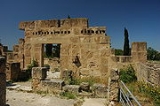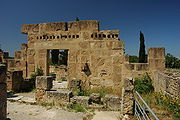
Utica, Tunisia
Encyclopedia

Carthage
Carthage , implying it was a 'new Tyre') is a major urban centre that has existed for nearly 3,000 years on the Gulf of Tunis, developing from a Phoenician colony of the 1st millennium BC...
near the outflow of the Medjerda River
Medjerda River
The Mejerda River is a river in Algeria and Tunisia. With a length of 450 km it is the longest river of Tunisia. It originates in northeastern Algeria and then flows eastwards to Tunisia, then entering the Gulf of Utica of the Mediterranean Sea...
into the Mediterranean Sea
Mediterranean Sea
The Mediterranean Sea is a sea connected to the Atlantic Ocean surrounded by the Mediterranean region and almost completely enclosed by land: on the north by Anatolia and Europe, on the south by North Africa, and on the east by the Levant...
, traditionally considered to be the first colony founded by the Phoenicians in North Africa. Today, Utica no longer exists, and its remains are located not on the coast where it once lay, but further inland because deforestation and agriculture upriver led to massive erosion and the Medjerda River silted over its original mouth.
"Utica" is from the Phoenician ˁattiq (identical to modern Arabic عُتَيقة and Hebrew עתיק) meaning "old [town]", contrasting with the later colony "Carthage", meaning "new town".
Utica's beginnings
Utica was founded as a port located on the trade route leading to the Straits of Gibraltar and the Atlantic, thus facilitating PhoeniciaPhoenicia
Phoenicia , was an ancient civilization in Canaan which covered most of the western, coastal part of the Fertile Crescent. Several major Phoenician cities were built on the coastline of the Mediterranean. It was an enterprising maritime trading culture that spread across the Mediterranean from 1550...
n trade in the Mediterranean. The actual founding date of Utica is controversial. Several classical authors date its foundation around 1100 BC. The archaeological evidence, however, suggests a foundation no earlier than the eighth century BC. Although Carthage was later founded about 40 km. from Utica, records suggest “that until 540 BC Utica was still maintaining political and economic autonomy in relation to its powerful Carthaginian neighbor”. By the fourth century BC, Utica came under Punic control but continued to exist as a privileged ally of Carthage.
Mercenary War
This relationship between Carthage and Utica began to disintegrate after the First Punic WarFirst Punic War
The First Punic War was the first of three wars fought between Ancient Carthage and the Roman Republic. For 23 years, the two powers struggled for supremacy in the western Mediterranean Sea, primarily on the Mediterranean island of Sicily and its surrounding waters but also to a lesser extent in...
, with the outbreak of rebellion among mercenaries
Mercenary War
The Mercenary War — also called the Libyan War and the Truceless War by Polybius — was an uprising of mercenary armies formerly employed by Carthage, backed by Libyan settlements revolting against Carthaginian control....
who had not received compensation for their service to Carthage. Originally, Utica refused to participate in this rebellion, so that the Libyan forces led by Spendius and Matho laid siege to Utica and nearby Hippocritae. The Carthaginian generals Hanno
Hanno
Hanno may refer to:* Hanno, Saitama, Honshū, Japan* Hanno , a lunar crater* Hanno , the pet white elephant of Pope Leo XPeople named Hanno:*Several ancient Carthaginians, including:...
and Hamilcar
Hamilcar
Hamilcar was a common name in the Punic culture. There are several different transcriptions into Greek and Roman scripts. The ruling families of ancient Carthage often named their members with the traditional name Hamilcar...
then came to Utica's defense, managing to raise the siege, but "the severest blow of all… was the defection of Hippacritae and Utica, the only two cities in Libya
Libya
Libya is an African country in the Maghreb region of North Africa bordered by the Mediterranean Sea to the north, Egypt to the east, Sudan to the southeast, Chad and Niger to the south, and Algeria and Tunisia to the west....
which had…bravely faced the present war…indeed they never had on any occasion given the least sign of hostility to Carthage.” Eventually, the forces of Carthage proved victorious, forcing Utica and Hippacritae to surrender after a short siege.
Third Punic War
Utica again defied Carthage in the Third Punic WarThird Punic War
The Third Punic War was the third and last of the Punic Wars fought between the former Phoenician colony of Carthage, and the Roman Republic...
, when it surrendered to Rome shortly before the breakout of war in 150 BC. After its victory, Rome rewarded Utica by granting it an expanse of territory stretching from Carthage to Hippo
Hippo Regius
Hippo Regius is the ancient name of the modern city of Annaba, in Algeria. Under this name, it was a major city in Roman Africa, hosting several early Christian councils, and was the home of the philosopher and theologian Augustine of Hippo...
. As a result of the war, Rome created a new province of Africa, and Utica became its capital, which meant that the governor's residence was there along with a small garrison. Over the following decades Utica also attracted Roman citizens who settled there to do business.
Roman Civil War
During the Roman Civil WarCaesar's civil war
The Great Roman Civil War , also known as Caesar's Civil War, was one of the last politico-military conflicts in the Roman Republic before the establishment of the Roman Empire...
between the supporters of Pompey
Pompey
Gnaeus Pompeius Magnus, also known as Pompey or Pompey the Great , was a military and political leader of the late Roman Republic...
and Caesar
Julius Caesar
Gaius Julius Caesar was a Roman general and statesman and a distinguished writer of Latin prose. He played a critical role in the gradual transformation of the Roman Republic into the Roman Empire....
, the remaining Pompeians, including Cato the Younger
Cato the Younger
Marcus Porcius Cato Uticensis , commonly known as Cato the Younger to distinguish him from his great-grandfather , was a politician and statesman in the late Roman Republic, and a follower of the Stoic philosophy...
, fled to Utica after being defeated at the Battle of Thapsus
Battle of Thapsus
The Battle of Thapsus took place on April 6, 46 BC near Thapsus . The Republican forces of the Optimates, led by Quintus Caecillius Metellus Scipio, clashed with the veteran forces loyal to Julius Caesar.-Prelude:...
in 46 BC. Caesar pursued them to Utica, meeting no resistance from the inhabitants. Cato, who was the leader of the Pompeians, ensured the escape of his fellow senators and anyone else who desired to leave, then committed suicide, unwilling to accept the clemency of Caesar. Displaying their fondness for Cato, “the people of Utica...called Cato their saviour and benefactor... And this they continued to do even when word was brought that Caesar was approaching. They decked his body in splendid fashion, gave it an illustrious escort, and buried it near the sea, where a statue of him now stands, sword in hand”. After his death, Cato was given the name of Uticensis, due to the place of his death as well as to his public glorification and burial by the citizens of Utica.
Roman status
Utica obtained the formal status of a municipiumMunicipium
Municipium , the prototype of English municipality, was the Latin term for a town or city. Etymologically the municipium was a social contract between municipes, the "duty holders," or citizens of the town. The duties, or munera, were a communal obligation assumed by the municipes in exchange for...
in 36 BC and its inhabitants became members of the tribe of Quirina. During the reign of Augustus
Augustus
Augustus ;23 September 63 BC – 19 August AD 14) is considered the first emperor of the Roman Empire, which he ruled alone from 27 BC until his death in 14 AD.The dates of his rule are contemporary dates; Augustus lived under two calendars, the Roman Republican until 45 BC, and the Julian...
, however, the seat of provincial government was moved by the Emperor Augustus
Augustus
Augustus ;23 September 63 BC – 19 August AD 14) is considered the first emperor of the Roman Empire, which he ruled alone from 27 BC until his death in 14 AD.The dates of his rule are contemporary dates; Augustus lived under two calendars, the Roman Republican until 45 BC, and the Julian...
to Carthage. "Although Utica did not lose its status as one of the foremost cities in the province. When Hadrian
Hadrian
Hadrian , was Roman Emperor from 117 to 138. He is best known for building Hadrian's Wall, which marked the northern limit of Roman Britain. In Rome, he re-built the Pantheon and constructed the Temple of Venus and Roma. In addition to being emperor, Hadrian was a humanist and was philhellene in...
was emperor, Utica requested to become a full Roman colony, but this request was not granted until Septimius Severus
Septimius Severus
Septimius Severus , also known as Severus, was Roman Emperor from 193 to 211. Severus was born in Leptis Magna in the province of Africa. As a young man he advanced through the customary succession of offices under the reigns of Marcus Aurelius and Commodus. Severus seized power after the death of...
, a native, took the throne."
The fall of Utica
In AD 439, the VandalsVandals
The Vandals were an East Germanic tribe that entered the late Roman Empire during the 5th century. The Vandals under king Genseric entered Africa in 429 and by 439 established a kingdom which included the Roman Africa province, besides the islands of Sicily, Corsica, Sardinia and the Balearics....
captured Utica, in AD 534 the Byzantines
Byzantine Empire
The Byzantine Empire was the Eastern Roman Empire during the periods of Late Antiquity and the Middle Ages, centred on the capital of Constantinople. Known simply as the Roman Empire or Romania to its inhabitants and neighbours, the Empire was the direct continuation of the Ancient Roman State...
captured it once more, and the Arabs were responsible for its ultimate destruction around AD 700. "Excavations at the site have yielded two Punic cemeteries and Roman ruins, including baths and a villa with mosaics".

